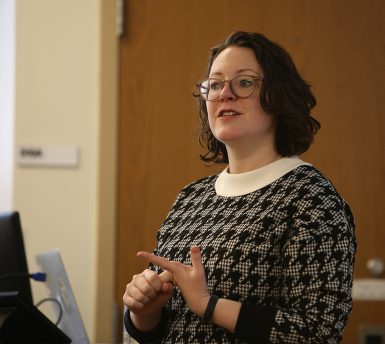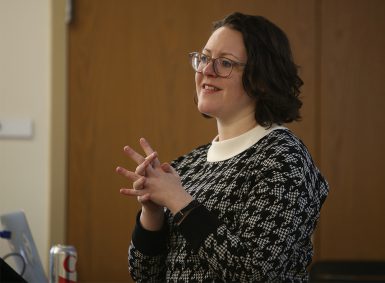Ellcessor research looks at technology, users with disabilities

Assessing issues surrounding and the future of emergency media requires an understanding of access beyond the “able-bodied” assumption, according to assistant professor Elizabeth Ellcessor.
Ellcessor, who is working on her third book, talked about her writing process at her talk, “What’s Your Emergency? Digital Media, Emergency and Research Design,” Jan. 20. It was part of the Media School’s weekly Friday talk series.
Disability has historically been overlooked as an important component in building emergency media like 911 technology and wireless emergency alerts.
“Talking in terms of technology and design, disability was often left out of the conversation,” she said.
Ellcessor discussed the need to take a mixed approach in understanding the use of media in emergency situations. Creators and researchers alike need to be wary of leaving out perspectives of disabled groups who may access technology differently.
“If we assume we know what access is, we put people on that trajectory. But that form of access advocacy often leaves out alternative perspectives and privileges—fairly paternalistic knowledge of what is important in terms of what people can and do do with digital media,” she said.
Ellcessor described her case study-based approach to conducting research for her book. Because technology changes constantly, she addresses this work as a though everything is historical. “This is how the world is at this moment,” she said, comparing the topic to capturing a moving target.
She also explained public concerns about the use of new media technology in emergencies, some of which tie into issues of race, class, urbanity and youth. A public service announcement in Indiana told potential users of text-based 911 alerts, “B4 U TEXT, VOICE IS BEST.”
Ellcessor said legislators were concerned that text-to-911 users would abuse the technology that would otherwise be very helpful to people who could not otherwise access emergency help.

“They were particularly worried that college students would text 911 and be like, ‘Hey, I’m out of beer! Help!’ 911 gets a lot of prank calls anyway,” she said. “They were particularly nervous about urban areas where people were less likely to have a land line and more likely to be reliant on cell phones.”
As a result, when text-to-911 rolled out in Indiana, it was released everywhere except Gary, Bloomington, Indianapolis and West Lafayette.
Personal safety app Companion: Never Walk Alone raised similar questions about targeting certain groups of people or parts of society. Ellcessor is currently researching how personal safety apps mirror or vary from safety technology like Life Alert, technology that has existed since the 1980s.
“One of the things that starts to draw attention to the identity politics of an app like Companion is that its features include a button that says, ‘I feel nervous,’ which its promotional materials indicate you can push when you’re in a ‘sketchy’ area,” she said.
Ellcessor explained that the identification of “sketchy” depends on the app’s users’ assumptions about differences in class and race that can shape their perceptions of safety. Featured users in ads and reviews are almost always young, white women, she said.
It’s important to study the usage surrounding digital media in emergencies to better understand a variety of groups and abilities, Ellcessor said. If only parts of the population can utilize new devices to further public safety, these devices aren’t doing their jobs.
“Reliable access is what makes emergency media useful,” she said. “If 911 only works sometimes or in some contexts, it ceases to serve that purpose.”
More:

